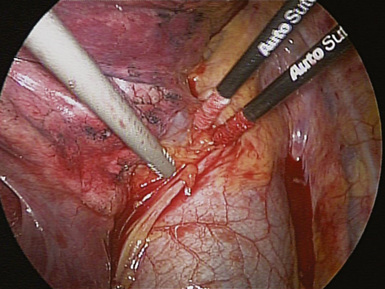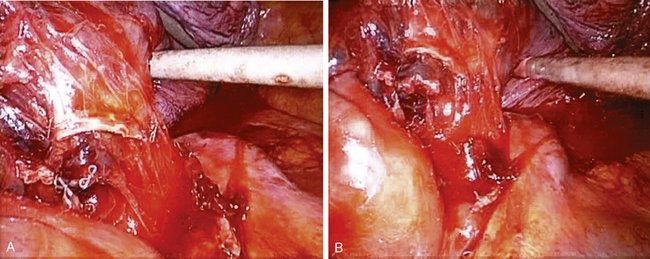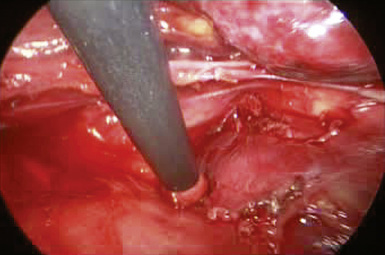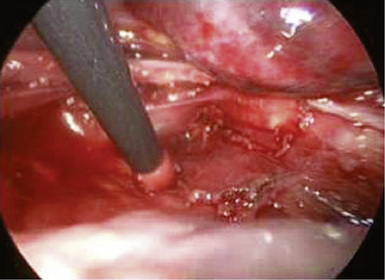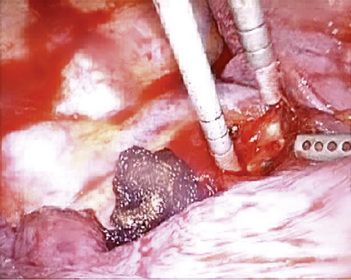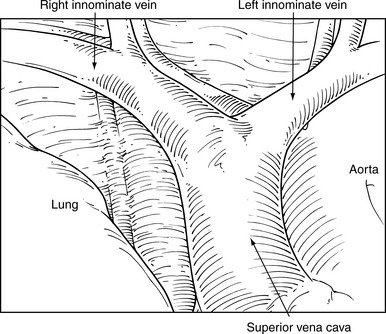CHAPTER 4 Applied Anatomy
Right Upper Lobectomy
Anterior Hilum
♦ The phrenic pedicle travels in a superoinferior direction on the superior vena cava and heart (Figure 4-1). Identify this structure so that it is not inadvertently injured in dissection of the superior pulmonary vein (SPV) (Figure 4-2). Using blunt dissection, the phrenic nerve and its vessels can be swept anteriorly away from the pulmonary vein (Figure 4-3).
♦ The important structures are the SPV, which is most anterior; the right pulmonary artery, which is posterior and often superior to the SPV; and the right upper lobe bronchus, which is the most posterior structure and often can be identified after the SPV and the truncus anterior branch of the pulmonary artery are divided (Figure 4-4).
♦ With retraction of the lung inferiorly from the posterior incision, the azygous vein can be identified passing to the superior vena cava from a posterior direction (Figure 4-5). It is positioned just superior to the truncus anterior branch of the pulmonary artery and the right mainstem bronchus. It should be dissected bluntly away from these structures. Mobilizing the azygous vein allows complete node dissection (Figure 4-6). If there are any problems with visualization of the nodes, the vein can be readily divided with the endovascular stapler.
Posterior Hilum
♦ After opening the posterior mediastinal pleura with the harmonic scalpel or cautery device, you can see the subcarinal space with the right mainstem bronchus and bronchus intermedius traveling in an oblique direction toward the lung (Figure 4-7).
♦ The azygous vein travels up the posterior chest wall before turning anterior at the level of the carina (Figure 4-8). With gentle blunt dissection, free the vein from the right mainstem bronchus.
♦ During the subcarinal node dissection, the entire subcarinal space is well visualized. The esophagus lies anterior to the left mainstem bronchus (Figure 4-9). After the nodes are completely resected, hemostasis is straightforward and can be accomplished with surgical cellulose and pressure. Use thermal energy discretely to avoid injury to the membranous right mainstem bronchus or the esophagus.
♦ Sweeping mediastinal pleura up toward the lung permits visualization of the right upper lobe bronchus taking off at a 90-degree angle from the right mainstem bronchus (Figure 4-10).
♦ The thoracic duct lies posterior to the esophagus and is rarely an issue, although with extensive node dissection in the subcarinal space, significant thoracic duct radicals can be disrupted. Use clips on any lymphatic vessels of significant size (>2 mm).
♦ Extensive paratracheal node dissection extends to the apex of the right chest. Identify the right subclavian artery and vein (Figure 4-11). Avoid extensive thermal dissection in this region to avoid injury to the right recurrent nerve. Medially and anteriorly, the left innominate vein joins the right innominate vein to form the superior vena cava (Figure 4-12). It should be identified during the high paratracheal node dissection. The pericardium can be seen at the base of the paratracheal node dissection after the nodes are removed.
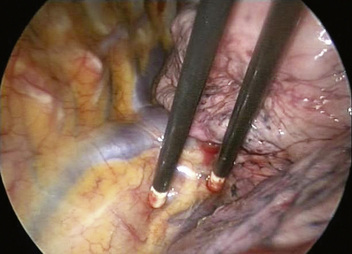
Figure 4-8 The azygous vein travels superiorly lateral to the right border of the thoracic vertebral bodies.
Right Middle Lobectomy
♦ The phrenic nerve courses in an inferior direction over the base of the middle lobe pulmonary vein (Figure 4-13). Similar to the dissection for the upper lobectomy, bluntly sweep away the nerve to avoid injury to it. The middle lobe pulmonary vein usually drains into the left atrium with the superior pulmonary vein but can drain separately or, rarely, with the inferior pulmonary vein. The middle lobe vein is composed of two segmental veins, with one anterior to the other or, less commonly, with one superior to the other.
♦ Unlike with the upper lobe, the bronchus sits posterior to the vein with the middle lobe pulmonary arteries posterior to the bronchus or slightly superior to the bronchus (Figure 4-14
Buy Membership for Cardiothoracic Surgery Category to continue reading. Learn more here



